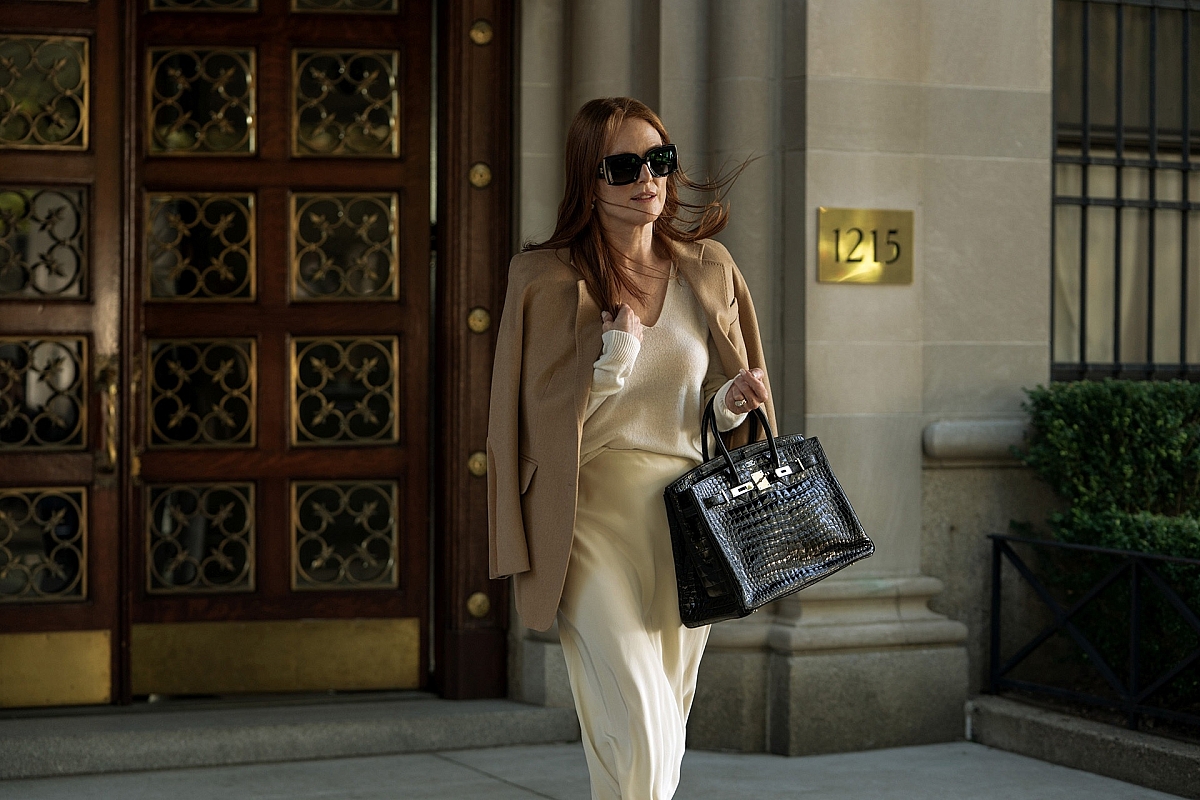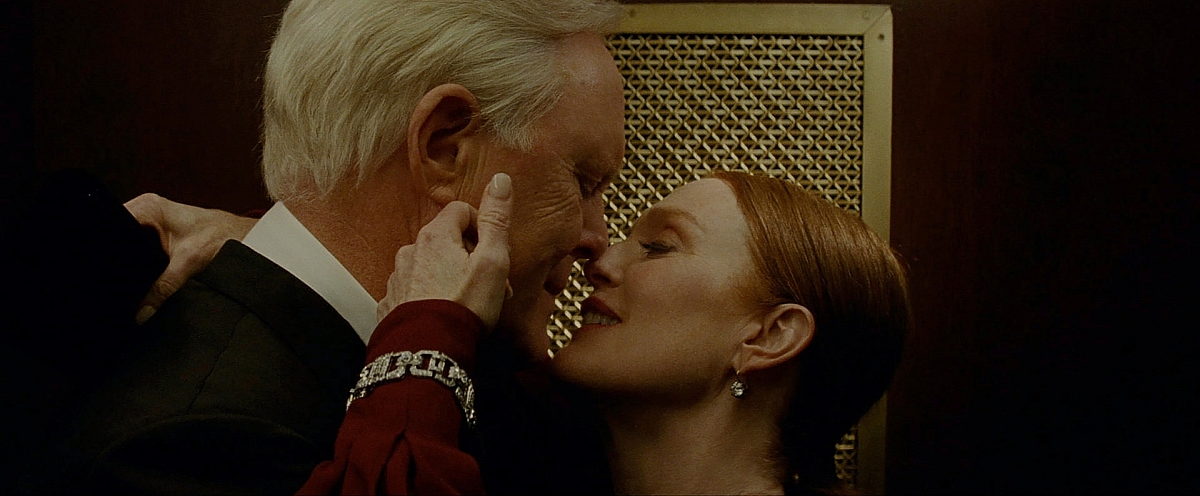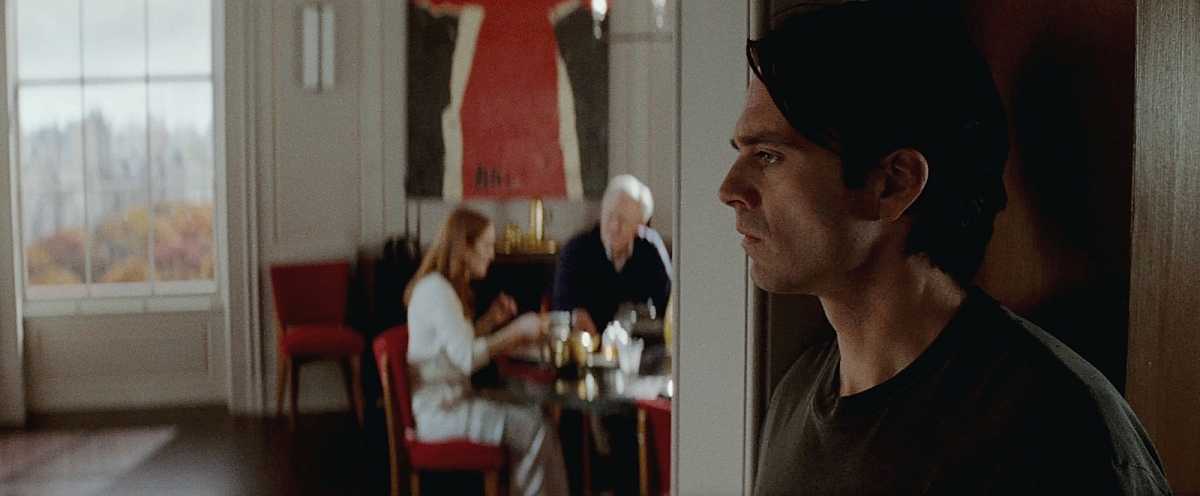DP Charlotte Bruus Christensen ASC used Kodak 35mm to create alluring looks for Apple TV+'s confidence-trick thriller 'Sharper'

Image courtesy of Apple.
Directed by Benjamin Caron for Apple TV+, the neo-noir thriller Sharper is presented in a series of interwoven chapters, each focusing on different characters, in a non-linear story about ruthless deception to swindle billions of dollars where no one is quite who they seem.
Produced via A24, the film marks Caron's directorial debut in features. Set in cozy interiors, plush Park Avenue penthouses, derelict warehouses and on the mean streets of New York, the separate chapters of the movie follow Tom (Justice Smith), the owner of a used bookstore in New York City; Sandra (Briana Middleton), a university student who enters into a romance with Tom; Max, (Sebastian Stan), a manipulative grifter who lives life in the shadows; and Madeline (Julianne Moore), soon to become the wife of mega-rich businessman, Richard Hobbes (John Lithgow).

Image courtesy of Apple.
Little more can be said about the plot without spoiling it, suffice to say that critics enjoyed the clever long-con narrative, lead performances and stylish, sumptuous cinematography on Kodak 35mm film by Charlotte Bruus Christensen DFF ASC, who conjured up different looks for the separate tableaux as part of a coherent whole.
"The script was a real page-turner. I was really hooked by the fast-moving twists and turns in the story of confidence tricksters conning one another, as well as the idea of money being a supporting character," Bruus Christensen recalls. "I liked the way the narrative was spread across different but connected chapters and was intrigued about Ben's vision to depict those with distinct moods – romantic, edgy, sinister, opulent – but all within a cohesive high-end Hollywood movie feel."

Image courtesy of Apple. BTS photos by Alison Cohen Rosa.
Filming on Sharper began in September 2021 and concluded some 45 shooting days later in November. Physical locations included a bookstore on Thompson Street in lower Manhattan and a suite on the 48th floor of the Marriott Marquis Hotel in Times Square. Sandra's apartment and Richard Hobbes's penthouse were set-builds, constructed on the stages at Silvercup Studios in Queens.
Bruus Christensen says an overarching reference was the neo-noir crime thriller Klute (1971, dir. Alan J Pakula, DP Gordon Willis ASC).
"I thought it would be fun to begin this project by watching the real thing, a print of Klute, as a reminder of how fundamental darkness is to visual storytelling. It's a film I know really well, and there's no one better at film noir than Gordon Willis," she says. "So I contacted my ASC brothers in LA and it turned out they had an original print from the 1970s, although there were a few scenes missing. It was a surprise to Ben, as he loves this movie, and we watched it together with some of the cast and crew at a theatre in New York.

Image courtesy of Apple.
"Separately, we also considered The Usual Suspects (1995, dir. Bryan Singer, DP Newton Thomas Sigel ASC) to see how it visually conveys suspicion and uncertainty, who's being dishonest and who isn't."
As for the developing looks for the individual chapters, Bruus Christensen says, "We worked really hard to visually separate the chapters from one another, and to differentiate between our locations, whilst still keeping things in one world.
"For the first chapter, when the romance between Tom and Sandra unfolds, we were inspired by the primary colors and warm, golden atmosphere of In the Mood for Love (2000, dir. Wong Kar-wai, DPs Christopher Doyle & Mark Lee Ping-Bing), especially for our bookstore and restaurant scenes.

Image courtesy of Apple.
"Sandra's chapter takes place in rough neighborhoods around Queens and the East River, and the raw, cold, steely-green lighting that you can see in films such as Blade Runner (1982, dir. Ridley Scott, DP Jordan Cronenweth ASC) were an influence.
"In the third chapter, the story switches to Park Avenue, where the theme of money really becomes prevalent. We looked at films such as The Thomas Crown Affair (1969, dir. Norman Jewison, DP Haskell Wexler ASC). Also, I already had a wonderful relationship with the production designer, Kevin Thompson, with whom I had worked previously on The Girl on The Train, and we found ways of getting the feeling of wealth into the set design, such as the wallpaper, which took on a golden lustre when it was lit from a specific angle."
Bruus Christensen is an unabashed champion of shooting on film, having previously captured Far from The Madding Crowd (2015), The Girl on the Train (2016), Fences (2016), A Quiet Place (2018) and The Banker (2020) all on Kodak 35mm film.

Image courtesy of Apple. BTS photos by Alison Cohen Rosa.
"I always fight for film, and having done a lot of work on celluloid, was prepared to argue in favor of using the texture and patina of film as the canvas for this story," she declares. "There is nothing like film to create the variety of engaging, atmospheric looks we wanted to achieve. I also know from experience how the focused mentality, discipline and attention amongst the cast and crew that comes with originating on film, would help with shooting ratios and have a positive impact on controlling costs. You don't just point and keep shooting when you are shooting film.
"Although I had not worked with Ben before, I quickly discovered he was keen to shoot on film too. Together with support from Anne Hubbell, VP of Motion Picture at Kodak, who provided reassurances about film processing and dailies, we put forward a highly persuasive aesthetic, practical and financial case, to which the producers acceded."
Working with Panavision New York, Bruss Christensen selected Panavision Millennium XL 35mm cameras and C-series Anamorphic lenses. "Ben was eager to see what different lenses would bring to the looks, and I conducted several tests for him. I really love those old C-series lenses having used them many times before, and he was in favor of using them when he saw those tests.

Image courtesy of Apple. BTS photos by Alison Cohen Rosa.
"The C-series Anamorphics are imperfect in a perfect way, in that they each have small differences and individual characteristics across the set – one might be slightly warmer, another might have softer edges. As you get to know them, you can make creative choices and use them for different ideas and what you want to portray.
"I like the bokeh, the vignetting and lens flares, and the way they breathe on focus pulls, all of which I wanted at different stages in the image-making of this production. And when you combine the C-series Anamorphics with celluloid film, plus atmospheric lighting, the result looks really confident and gorgeously cinematic."
As for the filmstocks, Bruss Christensen went with KODAK VISION3 500T Color Negative Film 5219 for the day interiors, night sequences and stage work, plus KODAK VISION3 250D Color Negative Film 7202 for overcast day exteriors and day interiors. She shot with KODAK VISION3 50D Color Negative Film 5203 for day exteriors, especially those towards the film's denouement, where its noted color rendition and image detail helped to differentiate the storytelling. Film processing was done at Kodak Film Lab New York.

Image courtesy of Apple.
"There are so many aesthetic advantages to shooting on film – the authentic skin tones, the natural warmth of the colors, the dynamic range to photograph both blacks and highlights in the same image. But one of the things that's important to recognize is that film remains a perfectly viable choice for directors and cinematographers. We are way beyond the crisis when people thought film was dead. It's here, it's alive, and I would encourage people to fight for film and grasp the opportunity to use it."
Along with her duties as cinematographer, Bruss Christensen also operated the camera for the vast majority of the production, with Aurelia Windborn keeping focus as 1st AC, and Elizabeth Hedges supporting as 2nd AC. The key grip was Mitch Lillian, who was also dedicated to pre-rigging the set-build sequences, with Sean Sheridan leading the lighting crew as gaffer.
"For me, lighting for modern film noir is about resisting temptation. It's about keeping things simple and true to the emotion and the place," says Bruss Christensen. "However, you face a really difficult challenge when your lighting truck is full of the latest LEDs, which you can easily use to punch a particular color or add effects into a scene. To my mind that can lead to a falsehood in your work. You have to resist thoughts about introducing color simply because you can and think about the truth of the space and the idea of darkness instead.

Image courtesy of Apple.
"This was my first collaboration with Sean, and it proved a very pleasant experience. The majority of the lights I used were trusty, old-fashioned, directional Tungsten lamps – like 1K, 2K, 5K and 10Ks and Parcans. I really enjoy using them to shape the light and pick out details, and I know how wonderful Tungsten light looks on celluloid film, especially the romantic scenes between Tom and Sandra, which we shot on 500T.
"Of course, we had some modern LED lights, like ARRI Sky Panels and Astera tubes, but I used them judiciously, mainly as soft sources to create overall ambience. For example, when we shot at night around the train station in Queens, the station itself was lit well-enough for shooting on 500T, but we concealed a lift with a 10K Tungsten to give a warm spot beneath the bridge, and hid several smaller Tungsten lights to create pools of warm sodium spill. To create a cooler, cyan ambience in the streets, we did a wet down and used two ARRI Sky Panel 360s on another concealed lift."
Of course, shooting interiors in tall buildings where there's no hope of controlling or introducing light from the outside, is the amongst every DPs biggest head scratchers. Such was the case when filming on the 48th floor of the Marriott Hotel.

Image courtesy of Apple. BTS photos by Alison Cohen Rosa.
"The room was essentially a white box, with low ceilings and tall windows that allowed reflected sunlight to blast in from buildings opposite," Bruus Christensen recalls. "Also, we were shooting in the winter months when it started to get dark from about three o'clock. Prior to the shoot, I asked my team to study the light thereby taking photographs every 15 minutes, so that I had an advance idea of how the room would change from morning until afternoon, and what kind of supplementary lighting were we going to need."
The solution turned out to be LED soft boxes from windows, constructed by Mitch Lillian, which could be quickly and easily repositioned as required, plus neatly-concealed Astera tubes that lifted the ambience to create a T4 exposure for the filmstock and Anamorphic out-of-focus purposes.
"This is exactly when LED becomes a gift to the cinematographer," she quips. "Those Astera tubes are superb when it comes to hiding them around a set, and they have a decent punch too."
Bruus Christensen concludes, "I've loved all of my previous experiences of shooting on film, all with different genres, stories and looks, and was able to bring a lot of that learning and knowledge into this production. Ben is a wonderful director, and my collaboration with him was supported by a really amazing team, who made the production and the final result something that I am very proud of."